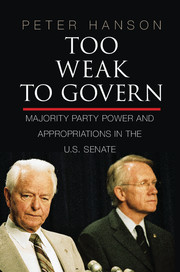1 - The Limited Influence Theory of the Senate
Published online by Cambridge University Press: 05 November 2014
Summary
The short walk under the Capitol dome from the House to the Senate connects two sharply different institutions. The framers of the Constitution aimed to give the House of Representatives and the Senate distinctive roles and personalities in the American political system. The House was meant to have an “immediate dependence on, and an intimate sympathy” with the people, while the Senate was meant to be insulated from popular passions and a “defence to the people against their own temporary errors and delusions.” The designs of the two chambers reflect these divergent goals. House members are elected for two years, senators for six. House members represent small, often homogenous districts, while senators represent much more diverse state populations. Today, the framers’ enduring stamp on the two chambers is evident in the fiery, tempestuous character of the House and the staid, tradition-bound Senate.
Other crucial distinctions between the House and Senate do not stem from the Constitution but from the rules that have been adopted by each chamber. The rules of the Senate protect the right of individual senators to participate in the legislative process but place a low priority on the efficient passage of legislation, while the rules of the House restrict a member’s opportunity to participate in order to expedite the passage of bills. These rules, in combination with the constitutional design of the two chambers, give each a unique and equally important impact on the production of legislation. Despite this fact, the Senate is more poorly understood than the House is. Scholars of Congress have filled the pages of academic journals and books with studies of the House because its large membership and firm rules of majority party control have made it amenable to quantitative analysis. The Senate has been comparatively neglected.
- Type
- Chapter
- Information
- Too Weak to GovernMajority Party Power and Appropriations in the U.S. Senate, pp. 1 - 37Publisher: Cambridge University PressPrint publication year: 2014



